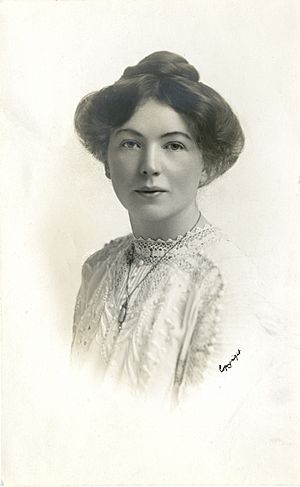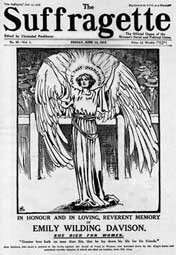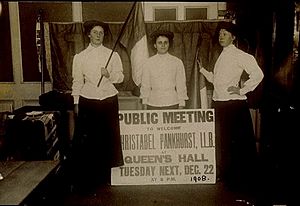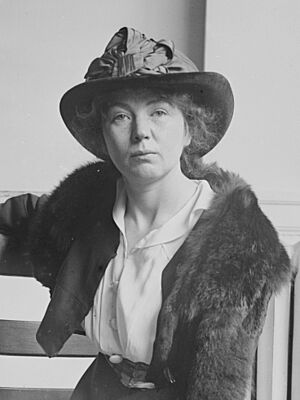Christabel Pankhurst facts for kids
Quick facts for kids
Christabel Pankhurst
|
|
|---|---|

Christabel Pankhurst, c. 1910
|
|
| Born |
Christabel Harriette Pankhurst
22 September 1880 Old Trafford, Manchester, England
|
| Died | 13 February 1958 (aged 77) Santa Monica, California, U.S.
|
| Resting place | Woodlawn Memorial Cemetery |
| Monuments | Emmeline and Christabel Pankhurst Memorial |
| Occupation | Political activist and suffragette |
| Movement | Women's Social and Political Union |
| Parent(s) | Richard Pankhurst Emmeline Goulden |
| Relatives | Sylvia Pankhurst (sister) Adela Pankhurst (sister) Richard Pankhurst (nephew) Helen Pankhurst (great-niece) Alula Pankhurst (great-nephew) |

Dame Christabel Harriette Pankhurst (born 22 September 1880 – died 13 February 1958) was an important British activist. She fought for women's right to vote, a movement known as women's suffrage.
Christabel was born in Manchester, England. She helped start the Women's Social and Political Union (WSPU). This group worked hard to get women the right to vote. From 1912 to 1913, she led some of the group's actions while living in France. Later, she supported Britain in World War I. After the war, she moved to the United States. There, she became a speaker for a religious movement.
Contents
Early Life and Family
Christabel Pankhurst was the daughter of two very active parents. Her mother, Emmeline Pankhurst, was a famous leader in the women's suffrage movement. Her father, Richard Pankhurst, was a lawyer and a socialist. Christabel had two sisters, Sylvia and Adela Pankhurst.
Even though her family sometimes struggled with money, they believed strongly in fighting for important causes. Christabel was known for being smart, charming, and confident. She had a special bond with both her parents. Her father even named her after a poem called "Christabel."
Education and Early Steps
Christabel learned to read at home before going to school. She and her sisters attended Manchester High School for Girls. Later, she studied law at the University of Manchester. She did very well in her law exams. However, because she was a woman, she was not allowed to work as a lawyer.
After her father passed away in 1898, Christabel returned home. She helped her mother take care of her younger siblings.
Fighting for Women's Rights

Christabel Pankhurst became a key figure in the fight for women's voting rights. In 1905, she made headlines by interrupting a political meeting. She demanded that women be given the right to vote. When she was arrested, she chose to go to prison instead of paying a fine. This act, along with her friend Annie Kenney, brought a lot of attention to their cause. Many more people joined the WSPU after this event.
Her mother, Emmeline Pankhurst, also became more active after Christabel's arrest. She was often sent to prison for her beliefs.
After getting her law degree in 1906, Christabel moved to London. She became the organizing secretary for the WSPU. She was sometimes called "Queen of the Mob." She was jailed again in 1907 and 1909 for her activism.
From 1913 to 1914, Christabel lived in Paris to avoid being arrested under a law called the "Cat and Mouse Act." This law allowed the government to release sick suffragettes from prison, then re-arrest them when they recovered. Even from Paris, Christabel continued to guide The Suffragette newspaper. Many supporters visited her there for advice.
When World War I started in 1914, she returned to England. She was arrested again and went on a hunger strike. She only served 30 days of a three-year sentence.
Christabel and her sister Sylvia often disagreed. Sylvia believed the WSPU should help working-class women with all their problems. Christabel, however, felt that getting the vote was the most important goal. She thought other issues could be solved once women had the right to vote.
Wartime Efforts
On 8 September 1914, Christabel Pankhurst spoke in London after her time in France. She talked about "The German Peril," urging people to support the war effort. She traveled around the country giving speeches to encourage men to join the army. Her newspaper, The Suffragette, changed its name to Britannia and focused on war news.
In her newspaper, Christabel called for men to join the military and women to work in factories. She also wanted all people from enemy countries living in Britain to be held in special camps. She believed Britain should completely block trade with enemy nations.
After the War
After some British women gained the right to vote at the end of World War I, Christabel decided to run for election in 1918. She ran as a candidate for the Women's Party. Her campaign focused on achieving a "Victorious Peace" and making Germany pay for the war. She lost by a small number of votes to the Labour Party candidate.
In 1921, Christabel left England and moved to the United States. She became a religious speaker and writer. She wrote books about her religious beliefs and was a guest on TV shows in the 1950s. She was known for being a unique mix of a former activist and a proper "English Lady." While in California, she adopted a daughter named Betty.
Later Life and Recognition
Christabel returned to Britain in the 1930s. In 1936, she was honored for her public and social work and became a Dame Commander of the Order of the British Empire. When World War II began, she moved back to the United States, settling in Los Angeles, California.
Christabel Pankhurst passed away on 13 February 1958, at the age of 77. She was buried in the Woodlawn Memorial Cemetery in Santa Monica, California.
A bust of Christabel Pankhurst was added to the Emmeline and Christabel Pankhurst Memorial in London in 1959. Her name and image are also carved on the base of the statue of Millicent Fawcett in Parliament Square, London, which was unveiled in 2018.
In 2006, a blue plaque was placed by English Heritage at 50, Clarendon Road, London, where Christabel and her mother had lived. Another blue plaque was put up in 2018 at 8 Russell Square, London.
Images for kids
See also
 In Spanish: Christabel Pankhurst para niños
In Spanish: Christabel Pankhurst para niños
- History of feminism
- List of suffragists and suffragettes
- Pankhurst Centre in Manchester
- Timeline of women's suffrage
- Women's suffrage in the United Kingdom
- Women's suffrage organisations





